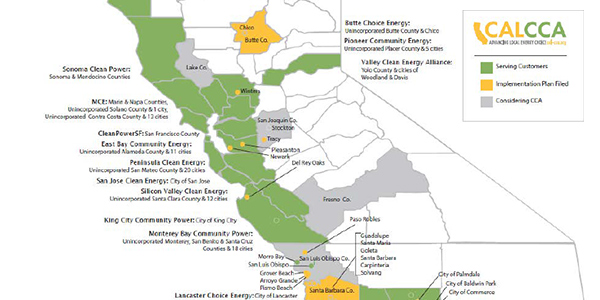An advocacy group representing California’s community choice aggregators (CCAs) on Wednesday called on Gov. Gavin Newsom to appoint an independent panel to review a pending joint agency report on the causes of the rolling blackouts that rocked the state in mid-August, leaving millions of residents without power during a record heat wave.
The request came the same day that WECC told its stakeholders of plans to produce its own analysis of the circumstances leading to the Aug. 14-15 blackouts and subsequent emergency events occurring in the days that followed.
During a voting meeting Thursday, California Public Utilities Commission President Marybel Batjer thanked residents and businesses for their efforts in heading off additional blackouts during another heat wave last week and assured them that the CPUC is working with CAISO and the state’s Energy Commission “on a joint investigation into the root causes of the events … that we intend to deliver to the governor later this month.” (In a meeting Tuesday, CAISO said the report could be finished as soon as early next week.)
But advocacy group CalCCA’s letter to Newsom expressed implicit skepticism over the impartiality of that effort.
“While the joint agencies are no doubt motivated to prevent future shortages, an objective eye will ensure that natural biases do not affect the characterization of the root cause or proposed mitigation measures,” wrote Beth Vaughan, executive director of CalCCA, which has 24 members and four affiliates.
CalCCA said its proposed review panel should consist of “former agency experts,” “non-market participants” selected by load-serving entities (including CCAs, investor-owned utilities and electric service providers) and “other key stakeholders.”
Like other industry participants, CalCCA pointed to declining resource adequacy as being a key factor in the rolling blackouts, saying the emergencies revealed an “urgent need” to reform the existing RA rules administered by the CPUC and CAISO “and focus the CPUC’s integrated resource planning process more rigorously on supply reliability.”
The letter also called on state officials to consider a new set of policy initiatives:
- Use of the CPUC’s procurement track of its 2021 integrated resource planning proceeding to “refine our understanding of near- and midterm reliability needs in the 2024-2026 time frame.” This would entail identifying specific technical needs for requirements such as capacity, energy and evening ramp; establishing a “fair process” for allocating those needs to LSEs for procurement; and providing “appropriate market incentive and regulations” for behind-the-meter resources to act as energy and capacity resources. CalCCA also wants the commission to develop “a deeper understanding of import resource availability and institutional barriers to securing firm import resources.” (See Theories Abound over California Blackouts Cause.)
- Legislative action to create a Central Reliability Authority responsible for coordinating the state’s RA with CAISO and potentially procuring backstop RA. (See Calif. Participants Float ‘Central Buyer’ RA Plan.)
- Collaboration between the governor’s office and California’s congressional delegation to extend the federal investment tax credit to cover standalone storage resources.
WECC to Take Wider View
Additional analysis of the blackouts was a topic of discussion during a virtual meeting of WECC’s Class 4/5 members (end users/state representatives) Wednesday, where an official said the regional entity aims to issue its own report on the emergency events by the end of the year.
Vic Howell, WECC director of reliability risk management, recounted to stakeholders that the organization followed every stage of the heat wave events and communicated developments to NERC as they unfolded. He noted that the RE tracked each CAISO energy emergency alert (EEA), all shedding of firm and non-firm interruptible load, and demand response usage.
“We also tracked transmission capacity and transmission limitations,” Howell said. “Although transmission wasn’t noted as being an issue during that event, the imports from outside California’s footprint were difficult to find because the neighboring entities were experiencing the same heat wave.”
Howell pointed out that CAISO issued 14 Level 1, six Level 2 and seven Level 3 EEAs over Aug. 14-19, equating to 62% of all EEAs issued in the Western Interconnection last year.
He said WECC’s report would examine the blackouts through the framework of NERC’s event analysis process but with a twist, “because we’re forming a larger internal team that includes folks from planning and from the resource adequacy group, in addition to the typical analysis staff.”
“We’re going to look into those conditions more broadly as a heat wave event, not a California load-shed event, to identify any other indicators of reliability issues,” Howell said. “The goal is to work really hard to produce a public report later this year with its findings, and there may be subsequent work that needs to happen after that.”
Asked whether it would support — or even participate in — the kind of independent review being sought by CalCCA, WECC told RTO Insider that while it doesn’t oppose such an independent analysis, its primary focus will be to conduct its own work through the NERC process.
“This process allows WECC to work with the entities involved to analyze what happened [and] why and identify lessons learned,” the RE said. “As part of the process, WECC will seek input from NERC [subject matter experts] and industry (via WECC’s Events Performance Analysis Subcommittee). WECC will look into the conditions on the system more broadly during the event to identify any additional indicators of reliability issues.”



